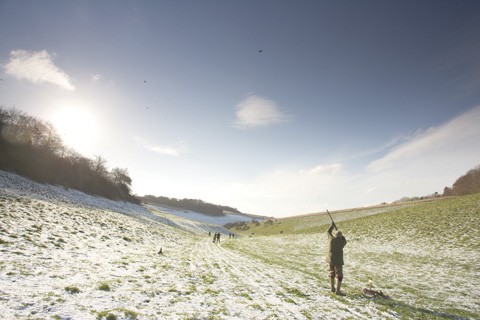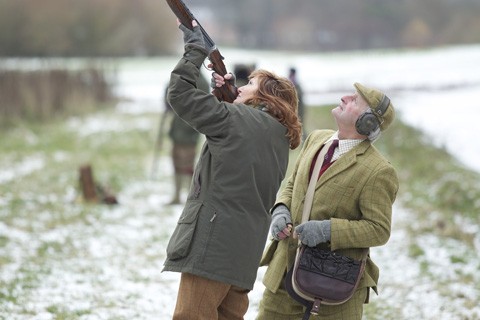Pheasant shooting at Iwerne Minster, Dorset

It’s a given that the West Country and the north of England have topography which consistently drags the wealthiest people from all corners of the globe to shoot in the UK.
However, Peter Schwerdt, the property whiz and man seen by many as being one of the most accomplished shots of his era, once said:
“Dorset is one of the pheasant shooting world’s best kept secrets, with those hidden valleys.”
As my adopted home county, I’m inclined to agree with him.
Plunging land formation, up to and over 100 metres high from the chalk plateau, has gifted the area from Iwerne Minster, Tollard Royal and beyond with ground which for some is as close to sporting greatness as it gets.
Contours like these usually elicit either anxious, rather sickly smiles from the guns or, in contrast, a dogged, vigorous changing of choke tubes to the most strangulating available, usually with an almost maniacally-determined grin.
With a park and coverts laid out by Lord Wolverton in the late 1890s, the Iwerne estate was sold to James Ismay in 1908, and the present owner, Phil Lever, purchased the estate from the Percy-Davis family in 1996.
 It was a cold day’s pheasant shooting in Dorset.
It was a cold day’s pheasant shooting in Dorset.
Sub-zero pheasant shooting
I was lucky enough to witness the sport enjoyed by some very accomplished guns on the first day of December – one of the coldest days last winter was cruel enough to conceive. Daytime temperatures of -19°C were recorded in Northumberland that week.
Phil and Suzie Lever welcomed the assembled team before they struck out into the cold from the house, suffused with wafts of fine coffee.
Various sets of teeth took no time at all to start chattering as the temperature struggled to reach -4°C.
The day had been taken by Fiona and Tim Leacock, a local family whose company just happens to sell Cessna private jets. As the vast gun wagon dropped us off for the warm-up drive, and my, we needed every second of it, the chat and chattering teeth quickly ebbed away.
The guns shivered and squinted skywards at the belt of trees that is Middle Wood, looming up into steely bright skies that silently sifted odd flakes of snow down into the mercifully meek breeze.
One of nine or so drives at Iwerne, this is the archetypal gradually intensifying, slow-burner of a drive.
 Pam Davies with loader Ray Brooks.
Pam Davies with loader Ray Brooks.
But, even as a first drive, it builds beautifully. The lying snow on this particular day lent the place a curiously unique and ethereal feel.
It altered the acoustics of everything too; the snow-insulated, frozen ground changing the familiar gun reports from blasts into clipped, popping sounds more akin to fireworks with their strange, suddenly diminishing, high-pitched echoes and reverberations.
In this prolonged cold snap, happily, the birds were quite used to the snow.
Fiona Leacock was pegged seven and, despite very numb fingers and toes and my loading efforts, picked out some very nice birds with a tidy little Italian 20 bore.
The Leacocks, when they’re not jetting around the globe, shoot on a fantastic little syndicate close to their home – 100 or so bird days, all archangels pretty much, so Iwerne’s silent stunners were merrily lapped up, with almost 50 birds coming to the cart after the first drive.
An egalitarian atmosphere
Janet Hunt, the wife of one of the guests, shooting instructor Peter Hunt, joined the regular picking-up team, with her quiet and diligent spaniels.
It was lovely to see the beating line, led by headkeeper Kevin Dancey, stopping to mingle and chat to the engaging and interested guns after the line’s descent in to the valley floor to the waiting transport.
Stalwart beater and keeper’s right-hand-man, the well-moustachioed David Shearn, was present for his 40th season in the line.
 Headkeeper Kevin Dancey.
Headkeeper Kevin Dancey.
Phil Lever eschews the whole cap-tipping, squire-archy thing; a seemingly gruff Northumbrian, he’s lived, sailed, travelled, shot and ridden to hounds as hard as anyone ever could, but is most at home among his family and ‘his team’ at Iwerne.
By the way, the Levers dabbled briefly with commercial pheasant shooting and quickly discovered it wasn’t for them.
With around 1,400 acres, the estate is lightly shot over, with less than a handful of their 16 days sold.
High-octane birds
The second drive was Hidden Valley and it is one of those drives which keeps on giving.
When you’re convinced it’s over, they still continue to trickle out from a remarkably small flushing point, or well behind it, in threes and fours; the true mark of a very disciplined line.
I stood with Pat McHaffey and he absolutely revelled in it. Constantly laughing, he muttered:
“I’ve never seen birds like this,” or “My, just look at that one,” as a freaky, stratospheric bird spiralled over the line simply yards out of shot.
At the other end of the line, husband and wife guests,Paul and Pam Bell from Jersey really came into their own, with a good rhythm and cartridge-to-kill ratio.
Brewster’s was the drive where every single gun seemed to be blazing away in unison, shot for shot; Mike Gaskell didn’t seem to miss much at all and David Rothschild, ably assisted by his wife and loader Anthea, coped admirably with one of Iwerne’s most intense and high-octane drives.
 The birds were high and fast on the day.
The birds were high and fast on the day.
It really did seem like a wall of glass above the line; Peter Hunt got fully into stride too.
As the light and the momentum faded at Wales’s Wood, a voice from the beaters called, ‘All out Kevin’, and the headkeeper blew a mournful note on his horn to bring the curtain down on a fantastic day’s pheasant shooting in the most romantic of settings.
A tidy team, day-dreaming of hot baths, tea and the impending raucous hotel supper, were very grateful to a special estate and the collection of souls who helped provide such glorious entertainment.
I too have been fortunate enough to shoot at Iwerne; like most, humbled and exhilarated in turns.
It’s impossible to say precisely why or indeed to list all of the reasons why one loves it so, one just does.
As Waugh wrote: ”A twitch upon a thread,” would have me scurrying there from, well… anywhere.
Know your geography
I must confess to having gone along with the notion that this golden area for pheasant shooting is actually set amidst various glacial valleys; not so. Indeed, it was the rivers and streams that should boast loudest about their part in the formation of this plunging landscape during the latter years of the last glacial period – 120,000 to just 12,000 years ago. During that cold period there were no glaciers or any permanent ice this far south but permafrost did prevail; the chalk was frozen stiff, whereas now it is a highly porous aquifer. Any waters that flowed during the warmer months or years eroded the chalk as it would any hard rock now. When the thaw finally did arrive, vast amounts of released water cut down rapidly into the chalk, forming deep and narrow incised valleys, now referred to as ‘dry coombes,’ for as long as the water table does not intersect the land surface. The freeze and thaw also contributed to the degeneration of the chalk valley sides, where the cracks and faults in the chalk were forced open by this repeated process. Amidst this dramatic scenery, Iwerne nestles alongside Ashcombe, Ashmore and the like; giants in our sporting world. Iwerne, rightly and quietly, takes its place beside them all.
For more shoot features click here








